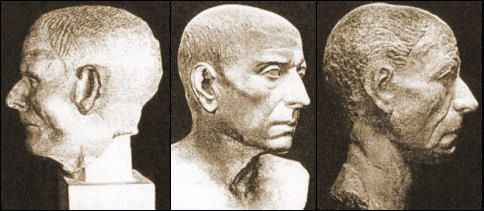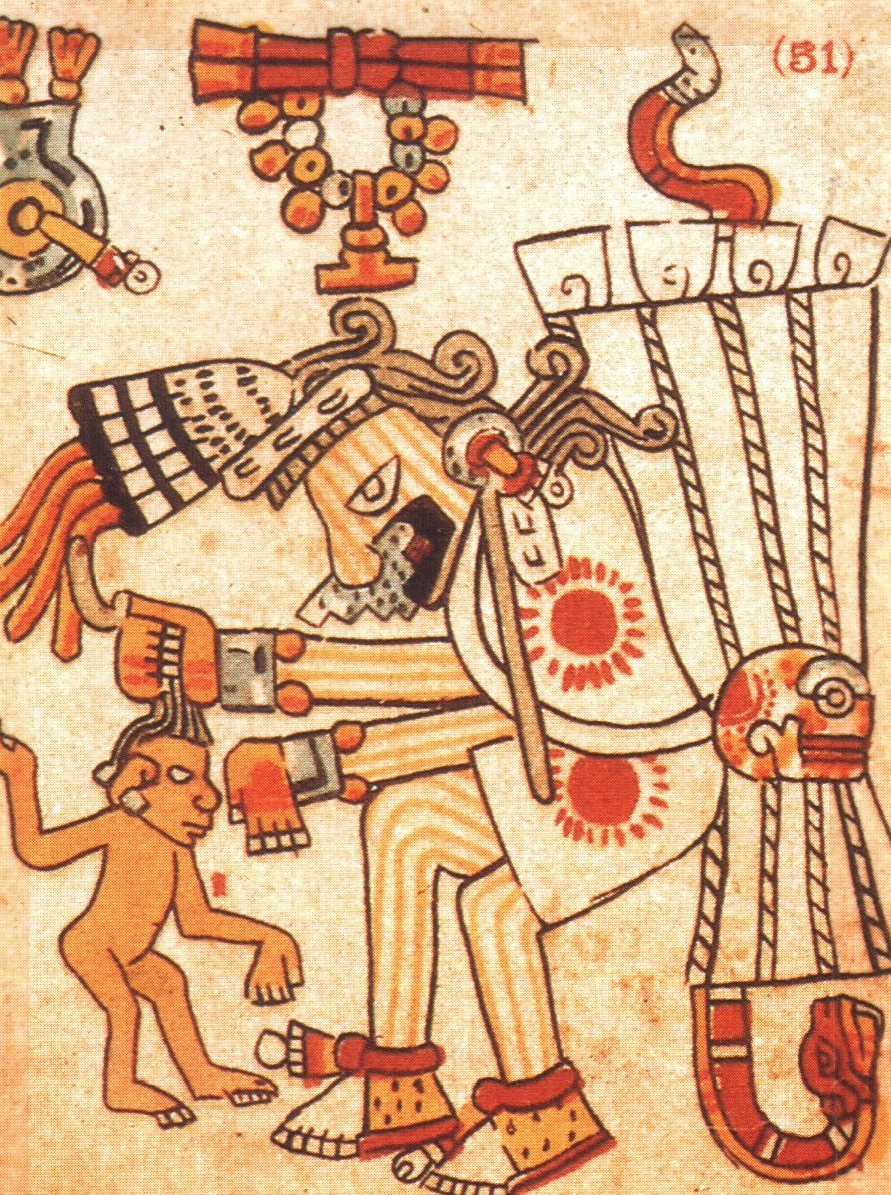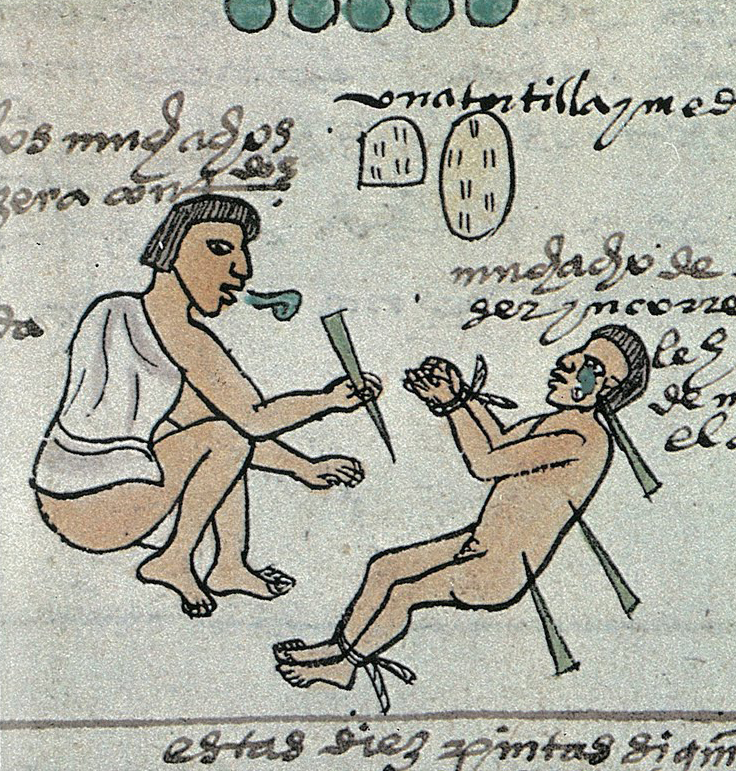Sahagún’s exclamation

I have worked in the heart of Houston, in the middle of its skyscrapers. The photographic postcards of downtown I saw in the hotel where I worked were deceptive: they flaunted only the luminous side of the Texan city. They never showed what I saw a few blocks away from my job: ugly streets, dreadful misery and homeless blacks.
Something similar can be said about the illustration of the previous chapter. If Tenochtitlan was kept beautiful it was because of the captive people from other towns forced to work. The Anonymous Conqueror tells us that the war prisoners whom the Mexicas would not cannibalize were made slaves. Had one of them written an autobiography, say, like the ones written by those women who escape the countries under Sharia, it would be a literary sensation in our times. And who had worked to build up the great temples and to open the wide avenues? The swarms of workers around the Texcoco lake, forced to work as part of the towns’ tribute to the empire, should not have looked very different from the scenes of Apocalypto before the camera showed us the center of the Maya city.
Eye to eye with its beauty, handicapped people, thieves and prostitutes were also visible in Tenochtitlan; and unlike the nobles, the common people carried only a loincloth and a special cape, not of cotton cloth but derived from the threads of the maguey cactus, and walked barefoot before their superiors. Only those elevated in the social strata were allowed to wear sandals. And just as in contemporary Mexico City, with its old mansions of Las Lomas or the Americanized building district in Santa Fe coexisting with the poorest neighborhoods, unlike the Nezahualcóyotl palaces and the mansions near the Teocalli, the Mexica common home consisted of a single sleeping room.
It is true that flowers and death adorn the lyrics of the Mexicas. But a line of one of their poems—“Let’s hope [prisoners] are dragged here, All the country must be desolated”—unveils the other side of the Nahua soul. In that world flowers rain incessantly beside the macabre, although magnificent, Mexica statuary. Every time I watch the panic stare of the Chac Mool found at the footings of the Great Pyramid of Tenochtitlan I ask myself what could he have been looking at (excavations performed between 1978 and 2000 in the temple recovered more than a hundred skulls, many of them of children). There is much truth, and also much deception, in the illustration of the previous chapter. For example, blood is not shown on the staircases. In the real Tenochtitlan, not in the idealized postcard, the very steep temple staircases—whose purpose was that the bodies could fall without obstacles—were stained with sacrificial blood (such staircases’ blood is visible in one of Rivera’s murals and in Gibson’s film).
In the pictorial reconstruction based on the plans of the architect Marquina, the pathos of the sacrifice that is taking place over the immense stone quauhtemaláctl is also missing, a stone that in the illustration is visible in the plaza of the Great Teocalli. This circular stone was used as theater of a gladiatorial sacrifice where the attackers gradually injured a leg, the head or the abdomen of a man tethered to the stone in a ritual properly called tlahuahuanaliztli, “the laceration.” (This was the human equivalent to a wounded bull in bullfighting, where those colorful sticks with a barbed point are placed on the top of the bull’s shoulder.) At the end of the gladiatorial sacrifice the human heart was extracted. This was such an important spectacle that the king Axayácatl requested the manpower of hundreds of men to drag the monumental stone from the road that united Coyoacán with Tenochtitlan. Needless to say, the comfort that in the illustration the noble who watches the spectacle experiences under the shadow is the inverse of what in real life the lacerated man must have felt in the world’s most beautiful city.
As of this writing, during the previous month the movie Apocalypto was still in the Mexican theaters. Contrary to the prognostication that it would not have a good welcome in Mexico, the film’s revenues displaced other memorable movies. Still, many people became furious claiming that it was unjust to focus on the dark side of the Maya culture instead of its mathematics, astronomy, or disappearance. Guatemala Indian activists asked the public not to go to the theaters and some people even denied the historicity of human sacrifice in pre-Columbian America. One of the craziest Mexicans wrote a month before the premier: “Personally, I’m ashamed of the little Spanish blood I have. I prefer to be a cannibal and demonstrate the splendor of this culture far higher than the Spanish. I crave to die at the obsidian’s edge. Our hearts only want the glorious death.” As a response to this rending of nationalist garments, in an editorial of the Mexican newspaper Reforma Juan Pardinas wrote (my translation): “The bad news is that this historical interpretation bears some resemblances with reality. Mel Gibson’s characters are more similar to the Mayas of the Bonampak murals that the ones that appear in the SEP school textbooks,” the Mexican Secretariat of Public Education, where children learn that the ancient Yucatecans used the zero before the Europeans. This is like saying that the Maya had been a civilization of thinkers and scientists: the Indian Athens of the Americas. But what not even Gibson dared to show us on the silver screen is that not only adults, but also small kids had been victims of Maya sacrifices.
The sacrifice of children in Mesoamerica began many centuries before the nomadic tribes of the north established themselves around the Texcoco Lake. In El Manatí, an Olmec archaeological site in Veracruz associated with a sacrificial ritual, bones have been found of babies; femurs and skulls. After the Olmecs there came the Teotihuacans. In the Pyramid of the Sun, the largest of the Valley of Mexico, Leopoldo Batres discovered at the beginning of the twentieth century several child skeletons: offerings to the god of the water (the Teotihuacans were contemporaries of the Mayas). When I saw a photograph of the skeletons in the Pyramid of the Moon it reminded me the horrific finding of sacrificed and cocooned humans in a high wall of the film Aliens.
Let us skip the history of similar findings throughout the twentieth century and focus on the present century. On December 2005 Reforma published an article about archeologist Ricardo Armijo Torres’s finding in Comalcalco, a Chontalpa region that some believe was the cradle of the Maya civilization, where the Mayas had perpetrated “a massive sacrifice of children of approximately one or two years old.” Chichén-itzá was named one of the new Seven Wonders of the World in 2007, with both the proud nationals and the foreign fans ignoring the fact that it had been the location of a ritual carnage. The Chac Mool at the top of the temple has a stone vessel used to hold the hearts of sacrificed humans. Thousands of Mayas died in ritual sacrifices in times of great droughts: a pointless holocaust that could not save Chichén-itzá from its fate. In the Maya ball game participants sometimes played with a decapitated head. The local legends recount that maids were thrown over into the cenote. This was confirmed recently by dredging one of them and discovering the skeletons. In addition to the physical evidence there exists pictorial evidence in Maya art about the sacrificed children. On page 25 of the September-October 2003 issue, Arqueología Mexicana published a painted scene from a ceramic of the Late Classic period “that indicates that child sacrifice was performed in well-defined circumstances” (my translation). On that very page it also appears a photo of Stelae 11 of Piedras Negras, Guatemala, showing a dead child with an abdominal cavity signaling that his heart was extracted. The sacrifice of small children continued in the Post-classic period. It was also performed in the first years of the Spanish colonization, albeit clandestinely and under the protective shadow of the caves.
The Mayas abandoned their big cities and their enormous crop fields of the Classic period. Without being subjugated they conserved distant relationships with the empire of the Mexicas. Once Maya hieroglyphics were deciphered, the vision of the Maya world changed. How well I remember the moment when I received the first information on this subject when reading a book-review in The New York Times about The Blood of the Kings, published in 1986 when I lived in the States. Although I didn’t keep the review, I remember that I got excited. In those days I wrote to a friend informing her that, far from being “the Greeks of America,” the Mayas performed rituals which objective was to provoke hallucinations in the mutilated people; that they venerated blood as a magical elixir and that every ceremony, whether of birth, marriage or death bore a tribute of human blood. I will quote extensively my letters to this friend in my next book. For now I would only add that I also wrote her about a Bonampak fresco showing a Maya prince “with a wicked face,” his court and the captives lying at his feet with panic-stricken eyes, apparently asking for a pity that they would not receive (a decapitated head can be observed on the floor). The Mayas had them cut their fingertips for the precious liquid to run free. The fresco is so famous that it appeared for some time on the Mexican twenty peso banknotes. A few years later, in the cultural magazine of Octavio Paz, I read the words of a Maya scholar, Michael Coe: “Now it is surprisingly clear that the Mayas of the Classic times, and their Pre-classic ancestors, were governed by an hereditary dynasty of warriors, for whom self-sacrifice and the spilling of blood, and the sacrifice by human beheading were supreme obsessions.”
Going back to the Mexicas, Diego Durán wrote about the ritual sacrifice of children in an important celebration of the Valley of Mexico with the Indian governors present. Several months of the Mexica calendar were devoted to the sacrifice of children at the top of the mounts, just what the distant Incas did. Children were transported in adorned litters along with their executioners chanting and dancing. They were made to cry so that their tears became a good omen for the raining season. The more the child cried, the happier the gods were.
The Mexica name for the first month of the year is Atlcahualo. It spans part of February in its Gregorian counterpart (the months of the Mexica calendar lasted twenty days). Children were sacrificed to the water deity Tláloc, and to Chalchiuhtlicue, “she of the jade skirt” and goddess of thermal waters. In other ceremonies children were drowned. In the third month of the calendar children were, again, sacrificed. The French ethnologist Christian Duverger wrote something that disturbed me. In his book La Fleur Létale (The Lethal Flower) this passage can be read:
The torments. In the context of the violent pre-sacrificial stimulations, I believe it is convenient to give a place to the torture, and precisely because it is only performed by the Aztecs before the human sacrifice. The torture is not necessarily integrated to the sacrificial prelude, but it may occur. The tearing off the nails of the children that had to be sacrificed to the god of the rain is a good example of ritual torture. The nails belonged to Tláloc. Through the sacrifices of the month Atlcahualo the Mexicans paid homage to the tláloques [Tláloc servants] and called for the rain. In order for the ritual to be effective, it was convenient that the children cried profusely in the moment of the sacrifice.
Then a face pack of hot rubber was applied to them and they were thrown over a pit that hardened the rubber and prevented them from breathing.
Tláloc, the rain god, was one of the most honored gods of the Mexicas. Along with the temple of Huitzilopochtli, Tláloc’s sky-blue temple existed in the highest spot of Tenochtitlan. With the skeletons discovered at the end of the twentieth century to the beginnings of the twenty-first century it was determined that dozens of children, most of them six-year-olds, were sacrificed and buried in the northwest corner of the first temple dedicated to Tláloc. (Keep in mind that the temple consisted of several layers; only the first survived as mere footings to the great Spanish destruction.) In June of 2005 the archeologists who worked on the temple ruins announced another discovery in the footings: a sacrifice of a very young boy to Huitzilopochtli, probably during the consecration of the building.

(This photo, the original in color, was taken by Héctor Montaño.) I confess that over the years I have harbored the morbid fantasy of finding out the aspect of the statue of Huitzilopochtli. I dream with some futuristic “machines to see the past” to know, with a wealth of detail, exactly how terrible the deity was. It is recognized that to know the soul of a culture there is nothing like having its art in front of us. Some of the pages that I like the most of Arthur Clarke’s short sci-fi stories appear in “Jupiter five,” where some explorers find a statue representing an alien in the art room of an abandoned ship thirty kilometers in diameter. Sometimes the Mexica world seems so distant from my civilization that the comparison does not look excessive to me.
But going back to my fantasy. The pages that I read with most interest of The Truthful History of the Conquest of New Spain (he refers to the Aztec Empire) were those in which Bernal Díaz described the great statue of Huitzilopochtli he saw at the top of the great pyramid:
And then our Cortés told Montezuma, with Doña Marina, the translator: “Milord, it has been your will, and much more your majesty deserves; we have been idle about seeing your cities; what I ask you as a favor, since we are already here, in your temple, that you show us your gods and teules [demigods].” And Montezuma said he first had to talk to his great papas [high priests]. And when he had talked to them he said that we were to enter a turret [the shrine at the pyramid’s top] and an apartment in the form of a room, where there were two altars, with very rich planking over the roof, and in each altar there were two shapes, giant-like, very tall and stout bodies.
The first one, to the right, they said it was Uichilobos [Huitzilopochtli], their god of war. It had a very broad face with deformed, horrifying eyes; and the whole body was covered with precious stones, gold and pearls and seed-pearls stuck on with wheat paste, which they make in that land with some sort of roots, and all of the body was full of it, and circled with some sort of great snakes made of gold and precious stones, and in one hand he held a bow and in the other some arrows. And a small idol standing by him they said was his page, he held a not very long lance and a shield rich of gold and precious stones; and around the neck of Uichilobos were Indian faces and things like the hearts of these Indians, the latter of gold and the former of silver, decorated with many precious blue stones; and there were braziers with incense, copal incense, and in them they were burning the hearts of three Indians they had sacrificed that day, and with the smoke and the copal they had done that sacrifice. Every wall of that shrine was covered with the blackness of the blood scabs, as well as the floor, and it stank so much.
The Indian baptized as Andrés de Tapia claimed that the statue of Huitzilopochtli was made of flour seeds with the blood of the children in a hardened paste; Durán, on the other hand, said it was made of wood. What is certain is that the priests devoted to its cult injured their tongues, arms and thighs with straws tainted with their own blood as an offering. Even the common Mexica injured himself far more than my cousin Sabina used to do. [This is recounted in an un-translated section, “Follow the mothers.”] He offered bleedings with maguey thorns by piercing his lips, ears and tongue. Men pierced their penis and the thorns stained with blood were placed in a shrine. The common Mexicas “decorated their doors with bulrushes containing their ears’ blood.” The priests, called papas by Díaz, had their ear lobes totally smashed as a result of these bleedings. In addition to tearing out the heart from the captives in the day 4-Earthquake, the common Mexica made these piercing penitences.
I mention all of this to throw light on the long Colin Ross quotation way above. The self-harmer women of Dallas pierced themselves because they believed in their wickedness and they needed an escape valve to discharge some of the pressure from the volcano of rage against their parents they carried inside. At the expense of their mental health and due to the locus of control shift, the evil of their parents had been transfused to their mentality since their childhood, making the perpetrator good and safe to attach to. Let us remember that this shift helps to solve the basic and fundamental dilemma of the human race: the affective attachment to our parents due to our long dependency. Ross does not comment on the ancient Mexicans, but according to Lloyd deMause this sort of self-injuring alleviated the Amerindians from the anxiety of the internalized image of a parent, now sublimated, that would castigate them because of a prosperity perceived as sinful (we will see where this gets us when analyzing the West of the twenty-first century). In other words, self-harming and harming others are two sides of the same coin. We displace our contained rage on others and on ourselves because of the absolute dissociation of the resulting emotions from the treatment we received in the past. If the pre-Columbian people displaced more than us it was simply due to a more primitive form of childrearing than ours. For Claude-François Baudez of the National Center of Scientific Research in Paris, the Mesoamerican sacrifice of others only replaced self-sacrifice “on the condition that the alter is equivalent to the ego.” Human sacrifice was, ultimately, the sacrifice of the ego “as it is shown in the first place by the primeval myths that precede self-sacrifice.”
Baudez illustrates his point with the Mesoamerican custom of eating the enemy or dressing up in his skin: a practice that occupied a place of first order of magnitude among the ancient dwellers of the continent. Although education in our times is abusive, pre-Hispanic education was infinitely worse. I cannot avoid thinking of the studies by two Mexican anthropologists that show that some sacrificed bodies underwent processes of flaying, removing the flesh from the body, dismembering, decapitation and even the showing off of the corporal parts as decoration, as can be read in the bone register (in our own times, only certain serial killers do this sort of thing). The psyche of the surviving siblings, cousins, relatives, close and not-so-close acquaintances of the sacrificed infants interiorized a greater homicidal impulse than ours: a good example to help us understand the difference among very distant psychoclasses.
Page 34 of the cited issue of Arqueología Mexicana recounts an alarming study. In Xochimilco, at the south of Mexico City, the remains of a three- or four-year-old child were discovered, whose bones presented an orange or translucent yellow coloration, terse or glassy textures, and the compacting of the spongy tissue, besides the shattering of the skull. Since in the mortuary treatment the Mexicas decapitated some bodies and sometimes boiled the heads for later esthetic exposition, the archeologists concluded that the head of the sacrificed boy had been boiled and that the skull was shattered due to the ebullition of the encephalic mass. The photograph of the skull has been published.
Moreover, at the beginning of 2005 a newspaper note was published about a finding in the north of Mexico City, in Ecatepec: an archaeological site with skeletal remains of eight sacrificed minors. According to the note republished by Discovery Channel: “The sacrifice involved burning or partially burning victims. We found a burial pit with the skeletal remains of four children who were partially burned, and the remains of four other children that were completely carbonized.” However rustic the Spanish soldiers were, when they saw for the first time in their lives this sort of behavior it blew their minds. The first texts about the New World ever published in Europe were the Cartas de Relación by Hernán Cortés. In one of these letters, published in 1523, the conqueror wrote:
They have a most horrid and abominable custom which truly ought to be punished and which until now we have seen in no other places, and this is that, whenever they wish to ask something from the idols, in order that their plea may find more acceptance, they take many girls and boys and even adults, and in the presence of these idols they open their chests while they are still alive and take out their hearts and entrails and burn them before the idols, offering the smoke as the sacrifice. Some of us have seen this, and they say it is the most terrible and frightful thing they have ever witnessed.
In another occasion Cortés recounted that his soldiers had captured an Indian who had been roasting the body of a baby to eat it. Fernando de Alva Cortés Ixtlilxochitl, a mestizo who wrote the codex that has his name, writes that one out of five children were sacrificed each year. The figure looks like an exaggeration: it is not known with certainty how many children were sacrificed in Mesoamerica. The most conservative contemporary studies say that in the Mexica world at least dozens of children were sacrificed each year.
One of the sources that the Mexican indigenistas hold in high esteem is the work of Bernardino de Sahagún, who set off to the New World in 1529, only a few years after the fall of Tenochtitlan. Scholars regard him as the first anthropologist. Even a passionate indigenista like Diego Rivera painted Sahagún with a young and clever face. Writing about the holidays of the so-called Aztec Calendar, Sahagún tells us of the rituals of the first month, called Atlcahualo or Quauitleoa by the Mexicas:
In this month they killed many children, sacrificing them in many places at the top of the mounts, taking out their hearts in honor to the gods of the water, so that they gave them water or rains.
What the Mexicas did on the second month of their calendar will be explained in the next section. In the third month, writes Sahagún: “In this holiday they killed many children in the mounts, they offered them in sacrifice to this god.” He also adds a general comment about the first months of the year:
According to the testimony of some [Indians], the children that they killed were collected the first month, buying them from their mothers, and they went on to kill them on all of the following holidays until the rainy season did indeed start; and thus they killed some children in the first month, called Quauitleoa [from February 2 to February 21]; and others in the second month, called Tlacaxipehualiztli [February 22 to March 13]; and others in the third month called Tozoztontli [March 14 to April 2]; and others in the fourth month, called Uey tozoztli [April 3 to April 22], so that until the rainwater season began copiously, in all holidays they crucified [sacrificed] children.
Those of us who live in the region formerly known as Tenochtitlan know that the Spring is dry here, which means that the natives felt an unrestrainable drive to murder the little ones. It is far-fetched that those who had the genius to construct at the center of the plaza a temple to Quetzalcóatl where the sunray of the dawn could be seen between the two shrines of the Great Pyramid, at the same time could not foresee the rainy season that contemporary Mexicans know perfectly. It is elemental that something more than soliciting the rains impregnated the psyche of the descendents of the Tenochcas. In the second book of the Florentine Codex Sahagún comments about the first month: “For this holiday they looked for suckling toddlers, buying them from their mothers.” And he adds: “For the killing they carried these children to the high mounts, where they had made an offering vow; from some of them they took their hearts out on those mounts, and from others, in some places on the lake of Mexico.” Both in discussions with me and in a heading of his orchestral homage to Bartolomé de Las Casas, my father has talked much about the “profound race”: the ancient Mexicans. I wonder how “profound” it was that the towns under Mexica rule offered, as a tribute, their little ones to be sacrificed. [This sarcasm against my father’s nationalism is understandable in the context of the previous section of Hojas Susurrantes.] About Pantitlán, Sahagún writes:
They killed a great quantity of children each year in these places and after they were dead they cooked them and ate them.
When I read that sentence I could not help but think about Mexico City’s subway station called Pantitlán. I ignored the fact that it was at the bottom of the lake. (In the times of the lacustrine city, the neighborhood where I write this book was also under the water.) In the same second tome of his encyclopedic twelve-book work about the traditions and customs of the ancient Mexicans, Sahagún recounts the details:
The places where they killed children are the following: the first one was called Quauhtépetl, it is a mountain range near Tlatelolco. The second mount where they killed children they called Ioaltécatl. The third mount on which they killed children they called Tepetzinco, it is that little mount that is inside the bordering lake of Tlatelolco, they killed a girl there. The fourth mount on which they killed children they called Poyauhtla. The fifth mount where they killed children was an eddy or basin of the lake of Mexico, that they called Pantitlán. The sixth place or mount on which they killed children they called Cócotl. The seventh place where they killed children was a mount that they called Yiauhqueme.
These poor children, before they were carried to the killing, were decorated with precious stones, with rich feathers and carried with blankets taking them on a litter, and they listened the playing of flutes and trumpets that they used. They had them all the night holding a wake and chanting to them songs of the idol’s priests, so that they did not sleep. And when they took the children to the places where they would be killed, if they were crying with very abundant tears, those who watched them crying were glad because they said it was a signal that rain was very imminent.
The most valuable phrase of the Sahagún opus is his exclamation that, in the most popular Mexican edition—the one by the Porrúa publishing house (2007 paperback edition)—appears on page 97:
I do not believe that there is a heart so hard that when listening to such an inhuman cruelty, and more than bestial and devilish such as the one described above, does not get touched and moved by the tears and horror and is appalled; and certainly it is lamentable and horrible to see that our human nature has come to such baseness and opprobrium that parents kill and eat their children, without thinking they were doing anything wrong.
Mel Gibson errs by quoting historian Will Durant at the beginning of his film. Human sacrifice in Mesoamerica was not a political aberration as presented in the film: it was a widespread social phenomenon. Gibson falsified history by putting as pacific a community of hunting tribesmen in contrast to the decadent city. The reality seems to be that the Amerindians who populated the small towns, and especially the naked natives that were exterminated in the Caribbean islands, were even more psychologically dissociated that the inhabitants of the refined double-city of Tenochtitlan-Tlatelolco. The variety of Indians who did not live in the big cities varied from the Caribbean cannibal to the Otomi people of the caves; from the fierce Guarani to the cannibalesque Chiriguano. In contrast to the villager of Apocalypto, the Tarahumara, the fearful Chichimeca, the Xixime and the Guarijio practiced the “dance of the head.” A virgin was shut away. A decapitated head was taken for her to “speak” to it, something that the woman had to do with fluctuating feelings of love and hate. Contrary to Gibson’s bucolic village in the middle of the Maya forest, this is what the tribesmen actually did in real history.
That the sacrifice was a popular and social phenomenon rather than a political one is shown in the fact that, after the elimination of the indigenous governments and the introduction of Christianity in colonial times, the natives adopted the cross as the form of child sacrifice. For a psychoclass that I labeled infanticidal in the previous chapter, the Spanish assimilation had incredible moments. The Indians went as far as nailing children by the hands and feet to a cross with their feet tied up before taking their hearts out. Still crucified sometimes they even threw them over a cenote, as can be read on page 81 of the second volume of the Archivo General de Las Indias complied by France Scholes and Eleanor Adams in 1938. The Indian priest used to say: “Let these boys die on the cross like Jesucristo died, whom they say was our lord, but we do not know if he was.”
___________
The objective of the book is to present to the racialist community my philosophy of The Four Words on how to eliminate all unnecessary suffering. If life allows, next time I will reproduce here the section on the Spanish chronicler Bernal Díaz. Those interested in obtaining a copy of Day of Wrath can request it: here.







